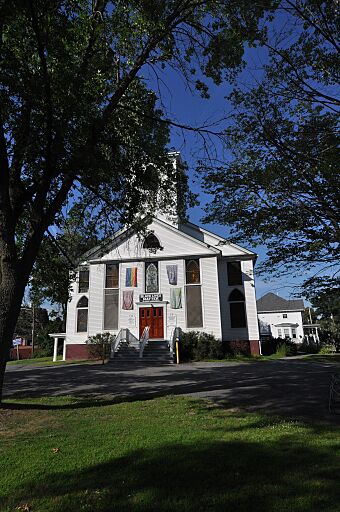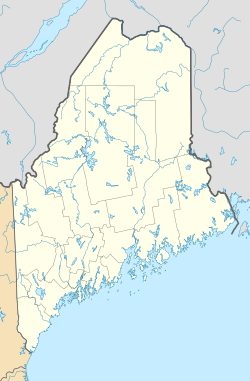Universalist-Unitarian Church facts for kids
Quick facts for kids |
|
|
Universalist Unitarian Church
|
|

1910 postcard view
|
|
| Location | 69 Silver St., Waterville, Maine |
|---|---|
| Area | 1 acre (0.40 ha) |
| Built | 1832 |
| Architectural style | Gothic Revival, Federal |
| NRHP reference No. | 78000181 |
| Added to NRHP | February 17, 1978 |
The Universalist Unitarian Church is an old and important church building. It stands in Waterville, Maine, where Silver Street and Elm Street meet. This church was built in 1832 for a group called Universalists, who started meeting in 1826. It shows a mix of two building styles: Federal and Gothic Revival. Because of its history and unique design, it was added to the National Register of Historic Places in 1978.
Contents
A Look at the Church's Past
For over 200 years, the Universalist Unitarian Church has been a key part of life in Waterville, Maine. It has played a role in the spiritual, religious, and social activities of the community. This church was formed when two local churches joined together. This happened ten years before their larger national groups also merged.
How the Universalist Church Began
In 1798, a traveling minister named Thomas Barnes started the Eastern Maine Association of Universalists. He held meetings in towns like Winthrop, Waterville, and Oakland. He was the first Universalist minister in the area that would become Maine.
In 1820, Reverend Sylvanus Cobb preached in Waterville for the first time. He was the second Universalist minister ordained in Maine. On May 28, 1826, he officially started the first Universalist Church in Maine. The church had twenty members and met at Rev. Cobb's home in Waterville.
Building the First Church Home
By 1831, the Universalist group became more organized. They decided it was time to build their own church. A man named Jediah Morrill became a Universalist and gave the largest donation to help build it.
On July 9, 1832, the current church building was finished. It had 60 pews and cost $4,100 to build. The church was officially opened in January of the next year. Members raised $360 to buy a bell. Jediah Morrill also gave $350 for a clock. That same year, Rev. Calvin Gardiner began his twenty-year time as minister. The church sometimes faced money problems and even closed for a year or two at times.
Changes and Repairs Over Time
In 1894, a chimney fire caused a lot of damage to the church. When they repaired the building, they turned the church to face the spot where Elm and Silver Streets meet. A new organ was bought. Members and church groups also gave beautiful stained glass windows.
In 1921, the church building was lifted up. New rooms called the Averill Parlors were built in the new basement area underneath.
The Unitarian Church and Merging
The Unitarian church was started in 1866. Its building was on Main Street in Waterville. By 1927, this church was also having financial difficulties. The two churches, Universalist and Unitarian, began talking about joining together.
By 1936, the Unitarian church's money problems got worse, and they decided to close their building. In 1952, the two churches, along with the Church of the Good Shepherd in Fairfield, officially united. They formed the Universalist Unitarian Church of Waterville that we know today.
The Bell Tower's New Look
The church's classic bell tower once held a clock that many considered the town clock. By 2008, the tower was in serious danger of falling down. The old tower was carefully taken down and sold. A new bell tower was built in its place. It was ready just in time for the Christmas Eve service that same year.
Church Building Design
The church building faces south towards a small, triangle-shaped park. This park is where Silver and Elm Streets meet, just south of downtown Waterville. The church is a single-story building made of wood. It has a pointed roof, wooden siding, and a foundation made of granite.
A two-part square tower rises from the roof. The first part of the tower has a clock. The second part is an open, eight-sided bell tower. Above this is a curved, eight-sided roof. The openings in the bell tower have pointed arches, which are a Gothic style. This pointed arch design is also seen above some of the church's windows and on the front of the building.
See also



